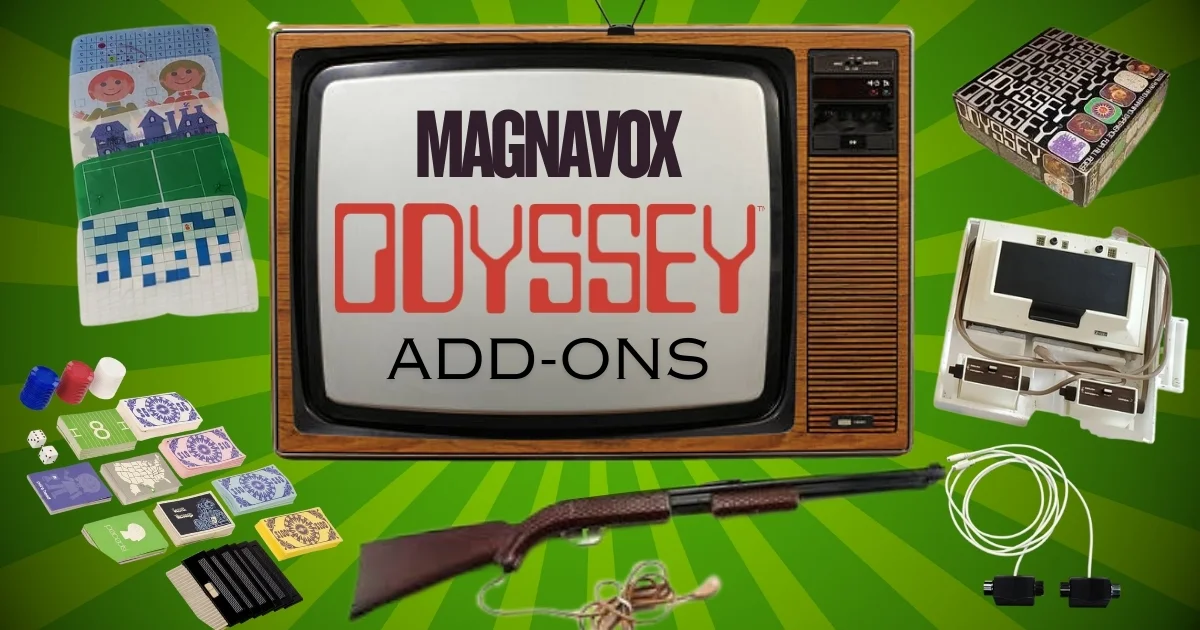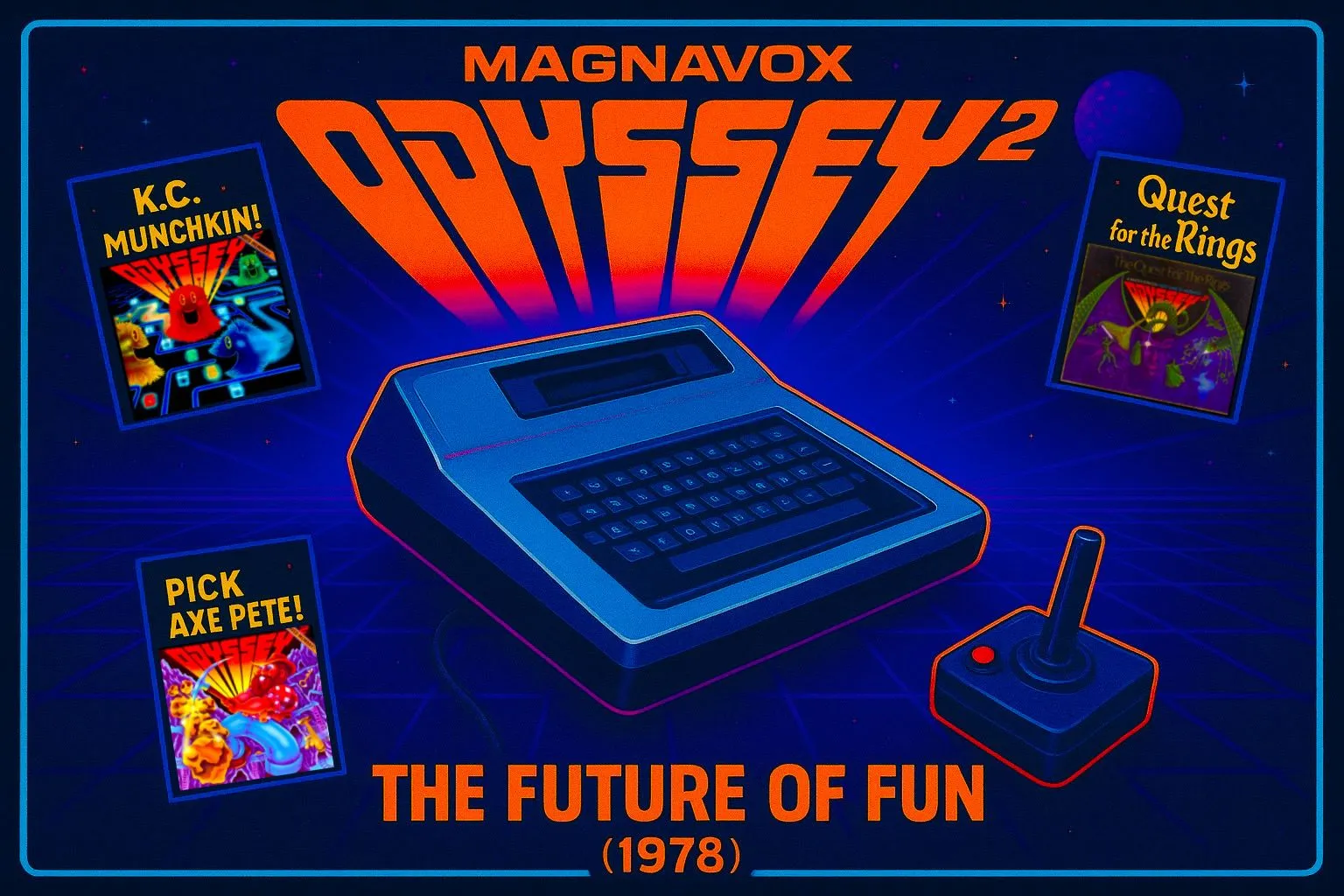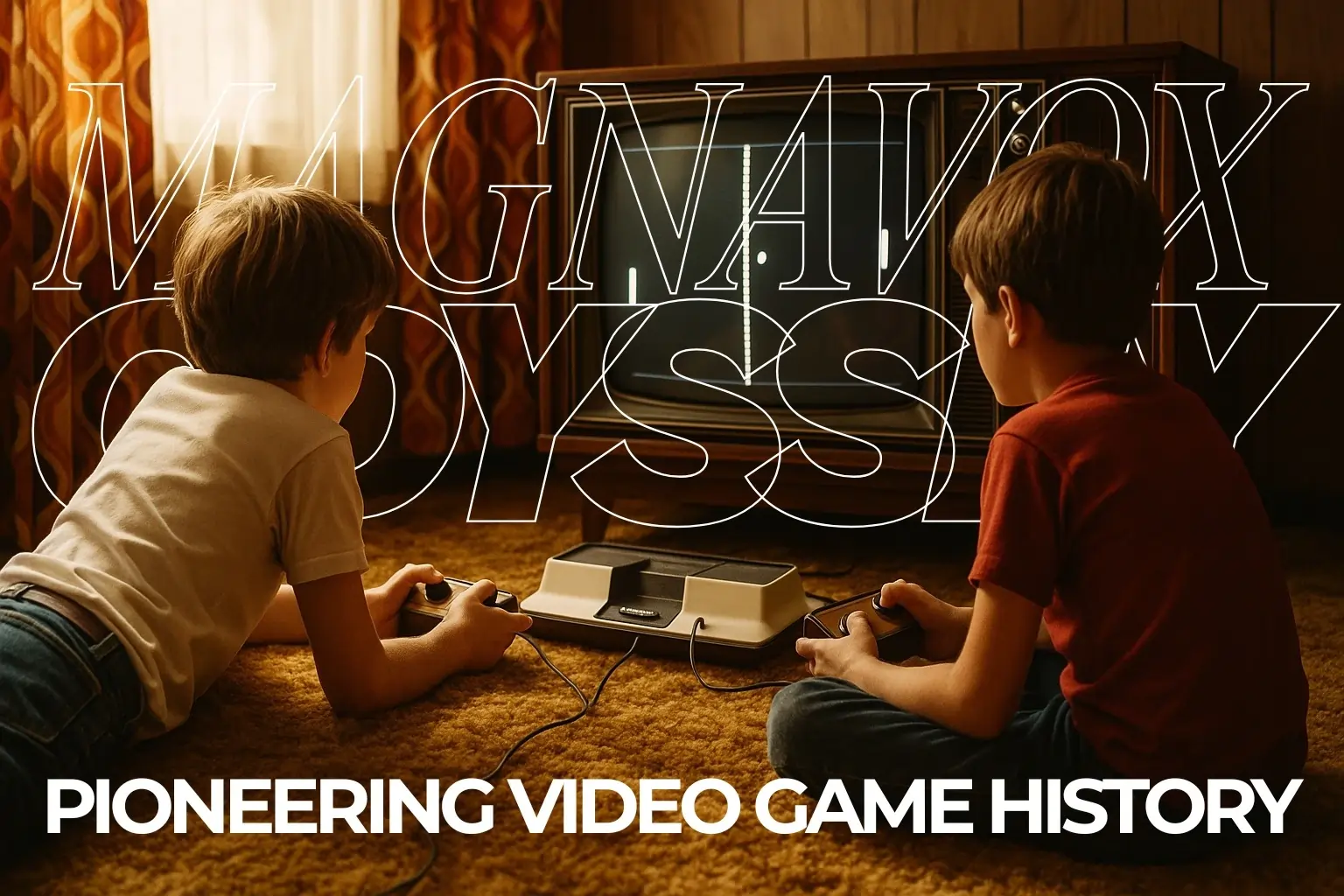Introduction: Why Magnavox Odyssey Accessories Matter
When the Magnavox Odyssey launched in 1972, it wasn’t just the world’s first video game console—it was a hybrid entertainment system that blended video games, board games, and physical play. Unlike later consoles that shipped with built-in graphics and sound like the Magnavox Odyssey 2 and others, the original Odyssey relied on overlays, accessories, and creative imagination to bring games to life.
The Magnavox Odyssey accessories were essential to the experience. They transformed a simple white box with knobs and wires into a pioneering platform that shaped the history of gaming. From the iconic Magnavox Odyssey light gun to cardboard score sheets and poker chips, these add-ons bridged the gap between living room fun and futuristic technology.
In this article, we’ll explore every accessory the Odyssey had to offer, their historical significance, and their lasting impact on gaming culture.
The Essential Role of Accessories in the Magnavox Odyssey
Unlike modern consoles that handle everything digitally, the Magnavox Odyssey relied heavily on its accessories to deliver a complete gaming experience. The base console itself could only generate simple white blocks on a screen. Without the overlays, dice, cards, and extra hardware, the Odyssey would have felt more like a tech demo than a family entertainment system.
Accessories were not optional—they were central to how the Odyssey worked. They filled in the gaps left by the system’s limited hardware and transformed bare-bones visuals into recognizable games. This clever approach allowed Magnavox to market the Odyssey as a versatile entertainment platform, appealing to both tech enthusiasts and families used to traditional board games.
Visual Enhancement
The most iconic accessory function was visual enhancement, achieved through colorful screen overlays. These sheets turned abstract white blocks into tennis balls, haunted house characters, football players, and racing cars. By introducing thematic backgrounds, overlays gave each Magnavox Odyssey game its identity and made the Odyssey’s limited graphics far more engaging.
This innovation showed that accessories could act as an extension of console graphics, an idea that paved the way for everything from cartridge-based add-ons to modern downloadable content.
Gameplay Mechanics
To make the Odyssey feel familiar to households in the 1970s, Magnavox leaned into the popularity of board games. Many Odyssey titles came with dice, play money, poker chips, and score sheets, which players used to track progress, add chance, and manage scoring.
This meant that Odyssey games weren’t just about what happened on the screen—they were hybrid experiences where the living room table became as important as the television set. In this way, the Odyssey was not just the first home video game console, but also one of the first to experiment with mixed-media gaming.
Immersion
Perhaps the boldest use of accessories came with hardware expansions like the Magnavox Odyssey light gun. This rifle-shaped peripheral allowed players to point and shoot directly at the TV, creating a level of physical immersion that no other console at the time could offer.
The light gun, along with extra controllers and optional hardware like the power adapter, demonstrated that gaming could go beyond knobs and dials—it could involve interaction with the real world. This concept would later inspire motion controllers, VR gear, and the tactile add-ons we see in modern consoles.
A Unique Blend of Gaming Worlds
By combining visual overlays, board-game elements, and immersive hardware, the Odyssey accessories created a unique blend of video and traditional gaming. Families weren’t just staring at a TV; they were rolling dice, writing down scores, swapping overlays, and pointing rifles at glowing squares of light.
This design philosophy set the template for future consoles and peripherals:
- Overlays hinted at customizable visual content.
- Dice and cards foreshadowed interactive storytelling and tabletop-inspired mechanics.
- The light gun anticipated a world of motion-based gaming.
In short, the Odyssey accessories turned a simple electronic box into the birthplace of interactive entertainment.
The Magnavox Odyssey Light Gun (Shooting Gallery)
A Pioneer in Video Game Weaponry
Perhaps the most famous accessory was the Magnavox Odyssey light gun, introduced through the Shooting Gallery add-on. Modeled after a rifle, it was a plastic peripheral shaped like a real firearm, and players could aim it at the television screen to shoot targets.
The Odyssey Shooting Gallery was groundbreaking—it became the first video game light rifle ever released. Unlike modern light guns such as the NES Zapper, the Odyssey’s rifle worked with a simple light-detection system: when you pulled the trigger, the gun detected light changes on the TV screen.
Games That Used the Light Rifle
The Magnavox Odyssey light rifle wasn’t just a novelty—it came bundled with a dedicated set of games that pushed the boundaries of what home consoles could do in 1972. These games were packaged in the Shooting Gallery add-on, a separate accessory kit that included the rifle and special overlays designed for use with the TV screen.
The Shooting Gallery Game Pack
The kit contained four distinct light rifle games, each built around different themes but using the same basic mechanics of aiming at targets on the TV screen:
- Shooting Gallery – The flagship game that gave the kit its name. Players used overlays depicting carnival-style shooting ranges, aiming at moving blocks of light to simulate knocking down targets.
- Prehistoric Safari – A time-travel-inspired shooting game where players “hunted” dinosaurs by aiming the light rifle at glowing targets on a prehistoric landscape overlay.
- Shooting Gallery: Dogfight – A simple air combat simulation where players took the role of fighter pilots, shooting at enemy aircraft projected as moving light squares.
- Shootout! – A Wild West–themed duel game. Players aimed their rifle at cowboy targets on the screen, combining the familiar trope of the gunslinger showdown with futuristic technology.
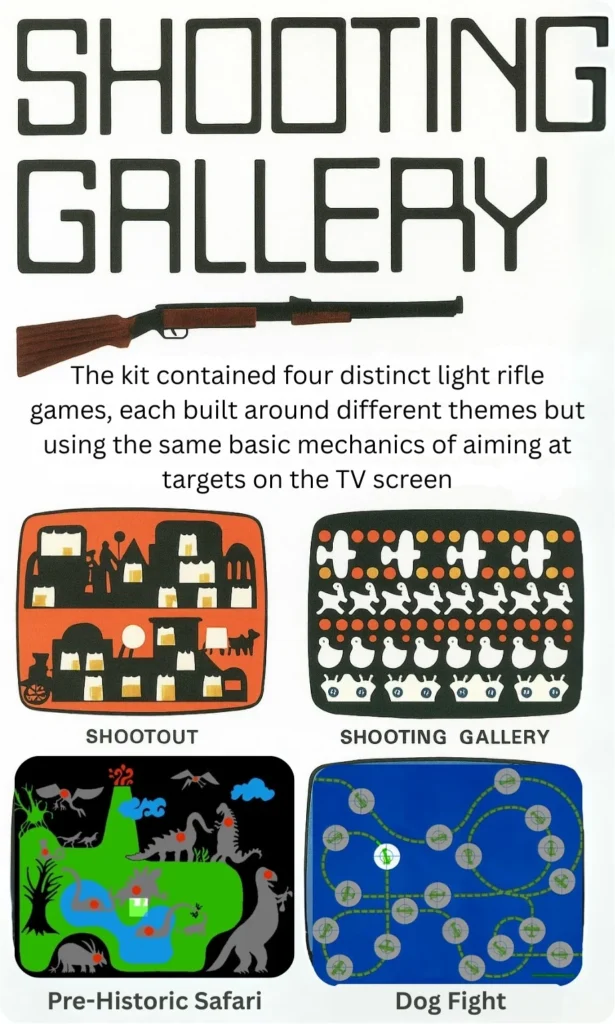
Gameplay Experience
While primitive by today’s standards, these games were groundbreaking for the time. Instead of controlling blocks with knobs, players interacted directly with the screen by pointing and firing the rifle. This was the first instance of a home console accessory that provided a true sense of physical immersion, decades before motion controllers like the Wii Remote.
Historical Significance
These rifle games were among the first interactive shooting experiences in home gaming history. They showed that the Odyssey was more than just Pong-style sports games—it could experiment with action-oriented, skill-based gameplay. The light rifle titles also helped establish a foundation for the light gun genre, which would explode in arcades and on later consoles like the NES, Sega Master System, and PlayStation.
Legacy of the Light Gun
The Magnavox Odyssey light gun may look simple by modern standards, but its impact on the evolution of gaming peripherals cannot be overstated. As the first commercially released video game firearm, it introduced players to the thrill of aiming and shooting at a television screen—something completely unheard of in the early 1970s.
Influence on Later Consoles
The Odyssey rifle directly inspired future gaming peripherals, establishing a design and gameplay blueprint that other companies would refine for decades:
- NES Zapper (1980s) – Perhaps the most famous descendant, Nintendo’s orange-and-gray Zapper became iconic with games like Duck Hunt. Without the Odyssey rifle, the Zapper may never have existed.
- Sega Light Phaser (1980s) – Sega followed with its own light gun for the Master System, which expanded the genre into more action-oriented shooting titles.
- Arcade Light Gun Games (1990s) – Classics like Virtua Cop, House of the Dead, and Time Crisis brought precision shooting experiences to the arcades, all rooted in the same concept first attempted by the Odyssey.
- Modern Motion Controllers – While today’s VR headsets and motion-sensing controllers (like the Wii Remote or PlayStation Move) use advanced tracking, their DNA can be traced back to the idea of interacting with games through physical pointing devices.

Collectibility and Rarity
Because the Odyssey Shooting Gallery set sold in smaller numbers than the main console, the rifle is now one of the rarest Magnavox Odyssey accessories. Complete sets with the rifle, overlays, and original packaging are especially hard to find, making them highly valuable among collectors of retro gaming memorabilia.
In today’s market, the Odyssey light gun is not just an accessory—it’s a piece of gaming history. Owning one means holding a tangible link to the birth of video game peripherals and the earliest attempts at interactive realism in the home.
Lasting Impact
More than a novelty, the Odyssey rifle proved that players craved immersion. It demonstrated that accessories could expand the gaming experience beyond simple controllers, paving the way for decades of innovation. From living rooms in 1972 to today’s VR setups, the spirit of the Odyssey light gun lives on in every interactive shooting device.
Screen Overlays: Bringing Color to Black-and-White Gaming
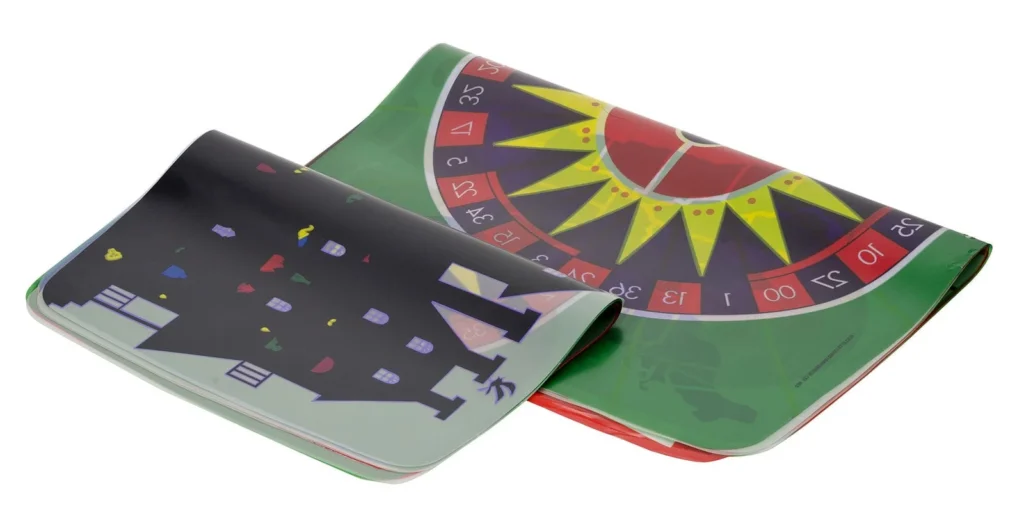
The Importance of Overlays
In the early 1970s, television sets were almost entirely black-and-white, and the Odyssey itself could only display basic white blocks on the screen. That meant games had no built-in color, scenery, or visual context. To solve this, Magnavox introduced screen overlays—thin, semi-transparent sheets of colored plastic that players manually taped to the front of their TV screens.
The Magnavox Odyssey featured a collection of around 22 transparent television screen overlays, each designed to provide the graphics and color needed for its games. Since the console itself only displayed simple black-and-white visuals, these overlays were essential for creating a more engaging experience. To accommodate different screen sizes, the system included two complete sets: eleven overlays measuring 18 x 21 inches and another eleven measuring 23 x 25 inches.
These Magnavox Odyssey overlays were more than cosmetic; they were the very heart of the gameplay. Without them, most games would have been reduced to abstract blocks of light. With them, however, the Odyssey could simulate recognizable playfields, making each title feel unique.
The overlays effectively acted as the Odyssey’s “graphics engine.” While later consoles stored visuals in code, the Odyssey offloaded much of its graphical responsibility onto these clever sheets. This solution allowed Magnavox to market a console with diverse experiences despite its limited hardware.
Notable Examples of Overlays
- Tennis Overlay – Perhaps the most famous of all, this overlay transformed a blank TV screen into a bright green tennis court, complete with a net. It gave life to the Odyssey’s tennis game, which predated Atari’s Pong and demonstrated how overlays could enhance competitive sports titles.
- Haunted House Overlay – One of the earliest attempts to create a narrative-driven setting in video games. The overlay depicted a spooky mansion with hallways and rooms, where players chased each other through corridors of light. It showed how overlays could introduce atmosphere and storytelling elements into gaming.
- Cat and Mouse Overlay – A playful, colorful sheet that turned the Odyssey into a cartoon-like chase game. Without the overlay, players would have just been blocks of light moving aimlessly, but with it, the screen became a dynamic playground for pursuit and escape.
- Roulette Overlay – A casino-inspired backdrop used in games of chance, combining the digital Odyssey with real-world gambling themes through poker chips, dice, and play money.
- Football Overlay – Simulated a football field and allowed for team-based competition, again showing how overlays could translate familiar real-world games to a TV screen.
Why Overlays Were Revolutionary
- Color Before Color TV – Even households with black-and-white TVs could suddenly enjoy colorful games.
- Affordable Innovation – Overlays were inexpensive to produce but dramatically expanded the Odyssey’s library.
- Creative Flexibility – By simply swapping overlays, Magnavox could advertise dozens of different “games,” even if the underlying gameplay logic was similar.
- Foundation for Visual Storytelling – Overlays introduced the idea that visual environments matter in gaming—something that would become central in later generations.
Collecting Odyssey Overlays Today
Because they were made of thin, fragile plastic, many overlays didn’t survive. Players often lost, damaged, or threw them away, making complete overlay sets extremely rare in today’s retro gaming market. Collectors prize them for their nostalgia, artistry, and historical importance—they’re not just game accessories, but artifacts from the dawn of interactive entertainment.
Cardboard and Board Game Accessories
The Magnavox Odyssey didn’t rely on digital scoring or complex graphics, so cardboard and board-game-like accessories filled the gap.
Included Items
- Play Money – used in economic-style games.
- Poker Chips – supported gambling-inspired titles.
- Score Sheets & Pads – allowed players to track points manually.
- Dice & Playing Cards – added random chance and strategic elements.
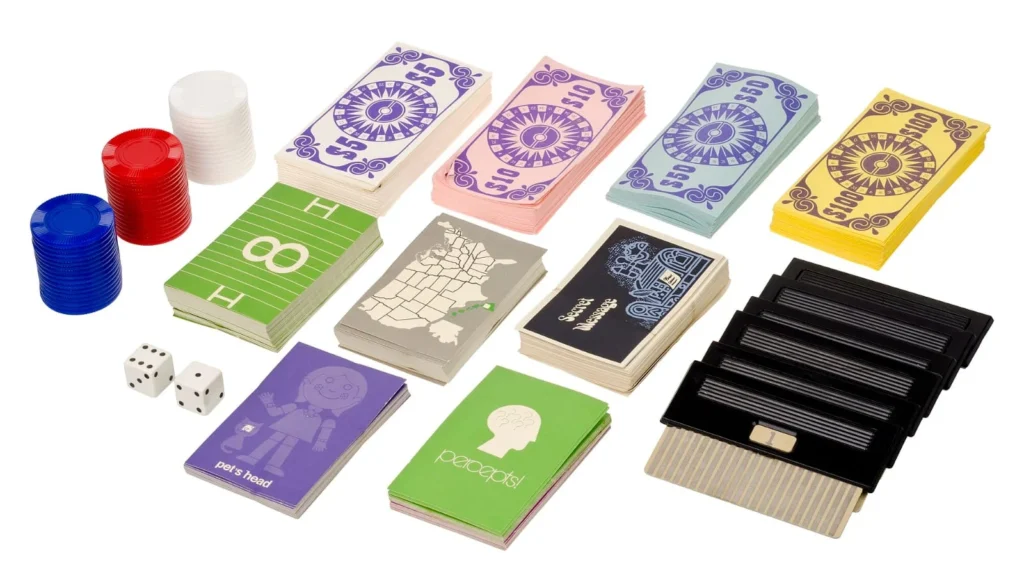
These items made the Odyssey feel more like a family board game set than a pure console. This approach helped Magnavox market the system to households unfamiliar with “video games.”
Impact on Hybrid Gaming
By combining physical and digital play, these cardboard accessories foreshadowed later innovations like Nintendo’s Amiibo or augmented reality toys-to-life games.
Extra Controllers and Hardware Expansions
The Magnavox Odyssey was designed as a two-player system right out of the box, which made sense since most of its games were competitive or cooperative. However, Magnavox also provided a handful of extra hardware options that expanded the system’s usability, flexibility, and longevity. These weren’t flashy add-ons like the overlays or light gun, but they were essential for keeping the Odyssey functional and enjoyable over time.
Additional Controllers
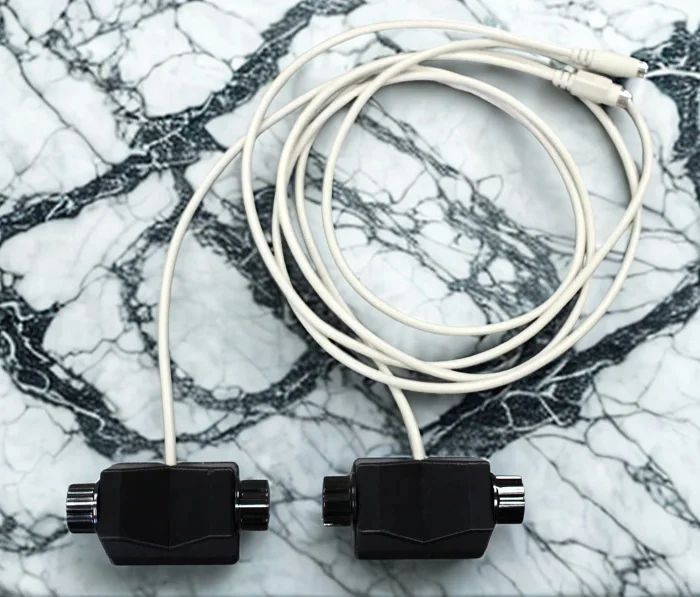
The Odyssey came packaged with two hardwired controllers that featured simple rotary dials (paddles) for horizontal and vertical movement. Since the console itself didn’t support more than two players digitally, extra controllers were sold mainly as spares. Families with multiple children—or heavy-handed gamers—often needed replacements, as the controllers were not built for long-term durability.
While these extra controllers might seem minor, they highlight an early instance of aftermarket support in gaming hardware, setting the stage for replacement and expansion peripherals that later became standard.
Game Card Cartridges
One of the Odyssey’s most unusual expansions was its set of Game Card Cartridges. Unlike later cartridges that stored software, these plastic cards acted as jumpers or switches. When inserted into the Odyssey, they reconfigured the console’s internal logic circuits to produce different game variations.
- Each card had a specific wiring pattern that determined the rules of play.
- Without the overlays and additional accessories, the cards alone wouldn’t have made sense to players.
- They were, in essence, keys to unlock new game modes, though the actual gameplay differences were often subtle.
This system made the Odyssey one of the first consoles to use a cartridge-based model, even if it wasn’t software-driven like the Atari 2600 or later systems.
Power Adapter (Optional)
The Odyssey originally ran on six C-cell batteries, which drained quickly during long gaming sessions. To solve this problem, Magnavox released an optional AC power adapter, allowing households to plug the console directly into the wall.
This accessory may not have been glamorous, but it was one of the most practical expansions for serious players. It extended playtime, saved money on batteries, and made the system feel less like a toy and more like a permanent home appliance.
Why These Expansions Mattered
Although simple, these extra hardware components show how Magnavox was already thinking about sustainability and flexibility in console design:
- Extra Controllers ensured that families could continue playing even if hardware wore out.
- Game Cartridges introduced the idea of expandable content, laying the groundwork for the cartridge era.
- The Power Adapter addressed a pain point and made the system more practical for long-term use.
Together, these add-ons demonstrated that the Odyssey wasn’t just a novelty device—it was a platform that could evolve with new accessories and player needs.
Rare and Obscure Accessories
Some Magnavox Odyssey accessories were produced in small quantities or bundled in special editions. Today, these are highly sought after by collectors.
- Odyssey Rifle Stand (limited release).

- Special Overlays tied to promotional campaigns.
- Box Packaging & Manuals, which are considered part of accessory sets by collectors.
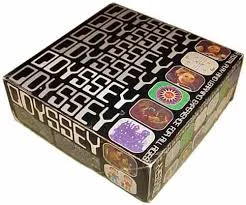
For retro gaming enthusiasts, finding a complete Magnavox Odyssey set with all accessories intact is the ultimate prize.
The Legacy of Magnavox Odyssey Accessories
The Odyssey accessories may seem primitive now, but they were trailblazers in gaming innovation.
Influence on Future Consoles
- The light gun inspired decades of shooting peripherals.
- The overlays laid the groundwork for graphical enhancements and even modern augmented reality concepts.
- The dice, cards, and score sheets showed how video games could blend with board games, inspiring hybrid experiences.
Collecting and Preserving Today
Collectors value Magnavox Odyssey accessories not just for their rarity, but for their historical importance. Preserving overlays, light guns, and cardboard pieces ensures that the origins of video game accessories are never forgotten.
Conclusion: The Lasting Impact of Odyssey Accessories
The Magnavox Odyssey accessories were more than add-ons—they were the foundation of interactive entertainment as we know it. By merging video technology with physical components, they created a unique gaming ecosystem that paved the way for future consoles.
From the Odyssey light gun to fragile screen overlays and quirky board-game pieces, every accessory contributed to the console’s identity. While the Odyssey itself may feel like a relic today, its accessories remain a testament to the creativity and ambition of the early 1970s.
For gamers, historians, and collectors, the Magnavox Odyssey accessories are not just nostalgic—they’re the roots of an entire industry.


